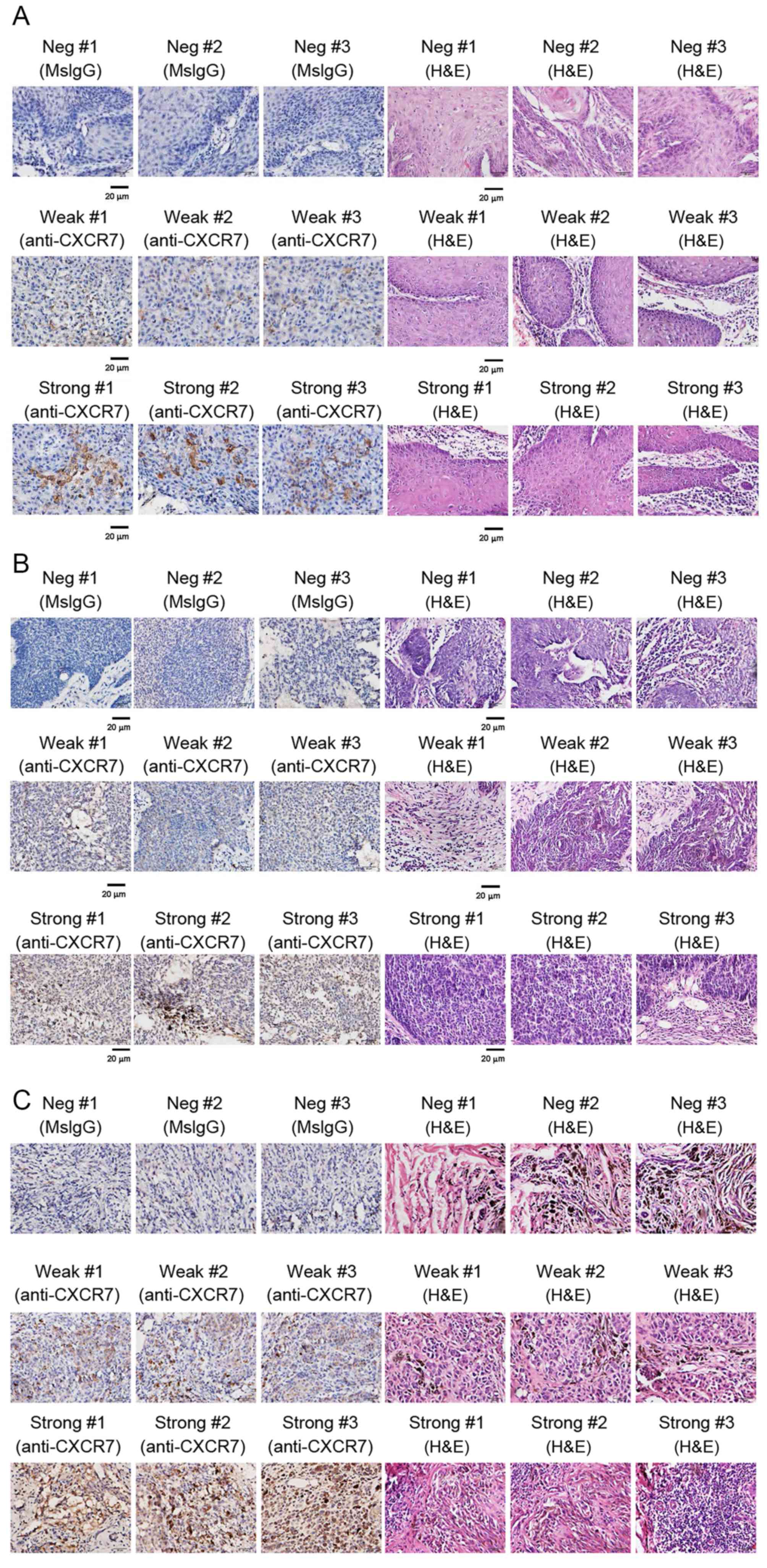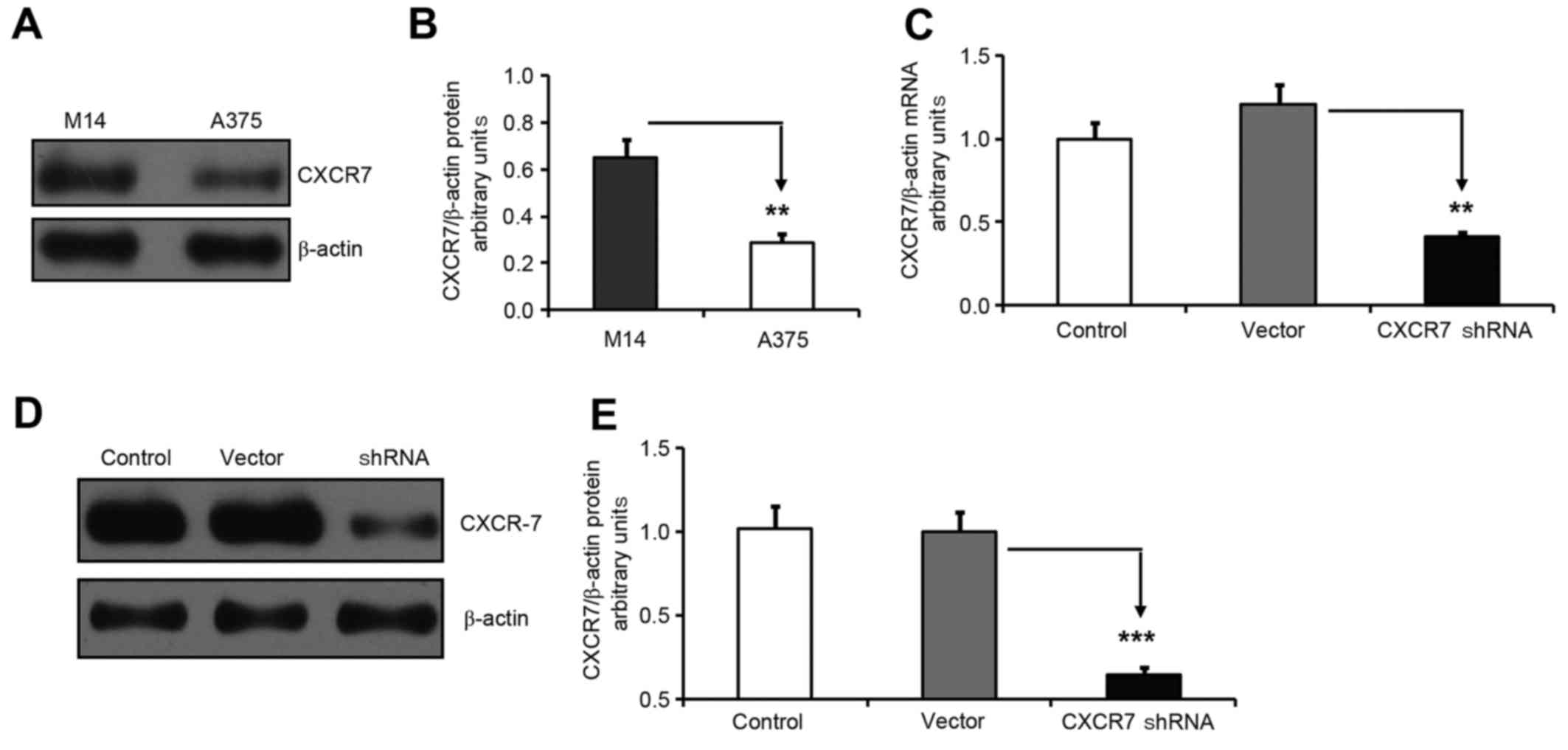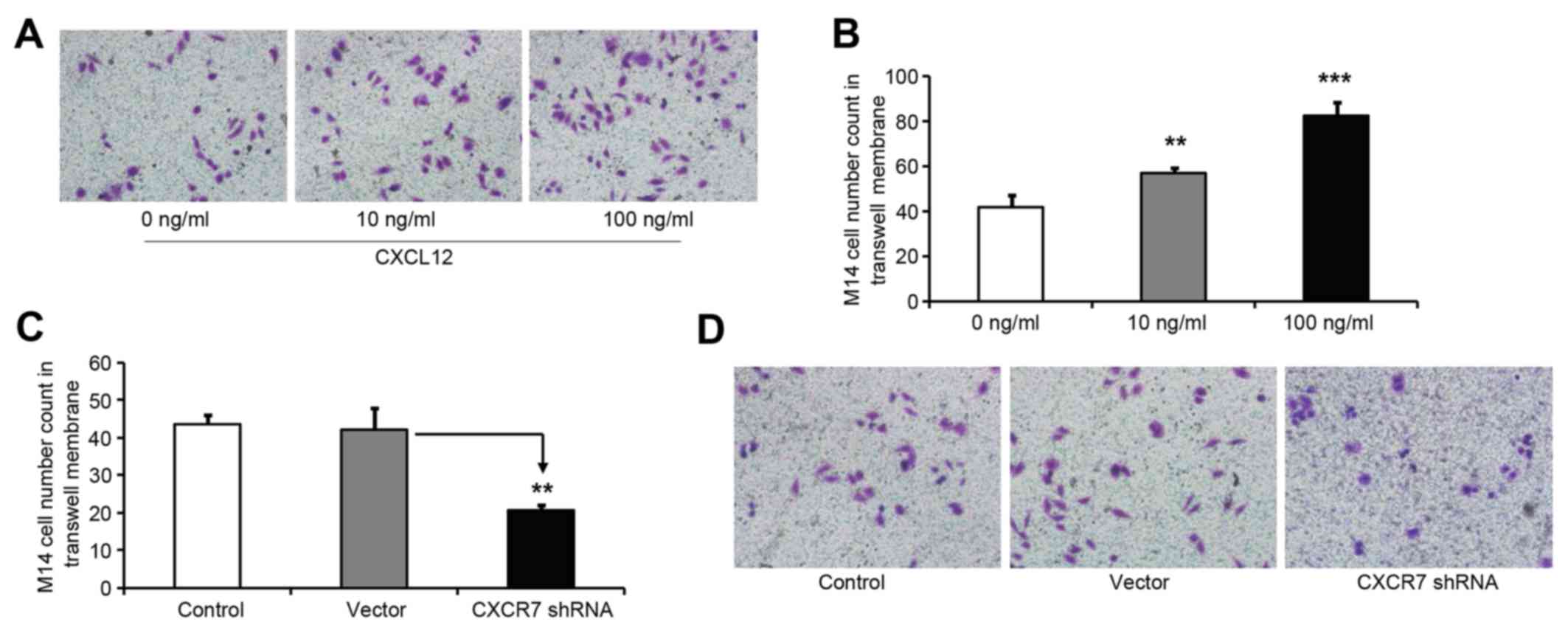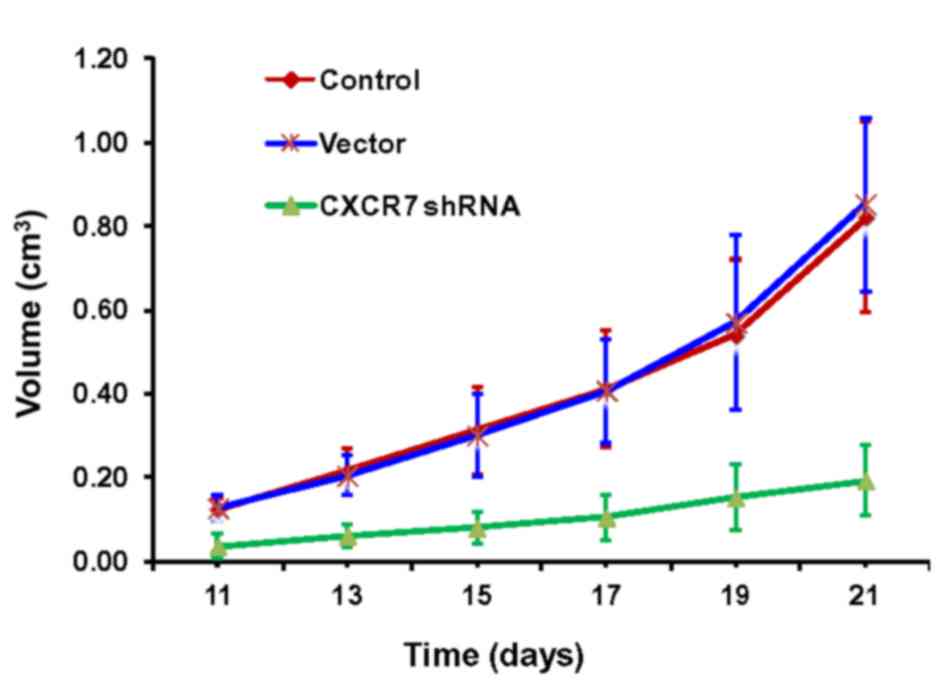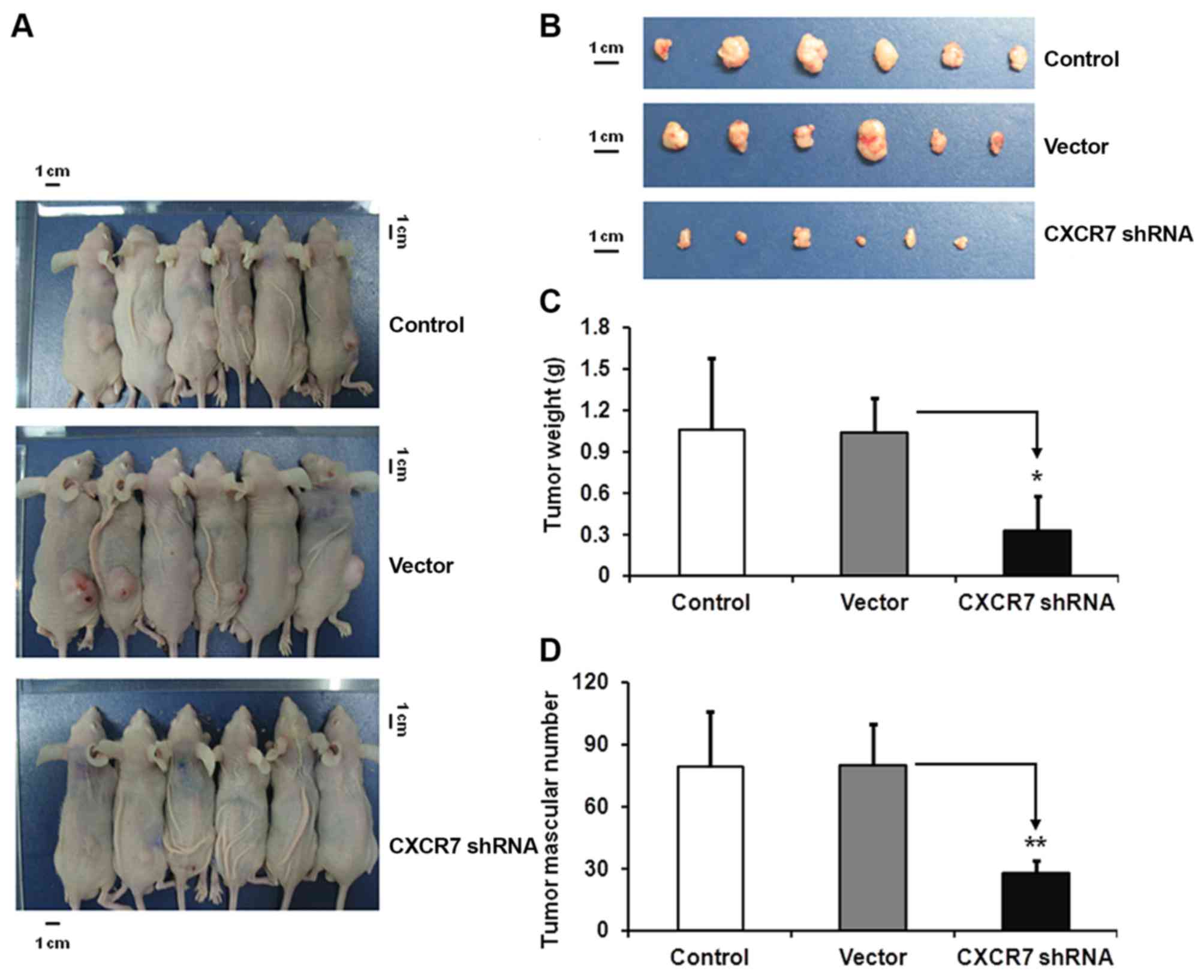Mechanisms of CXCR7 induction in malignant melanoma development
- Authors:
- Published online on: August 4, 2017 https://doi.org/10.3892/ol.2017.6720
- Pages: 4106-4114
-
Copyright: © Li et al. This is an open access article distributed under the terms of Creative Commons Attribution License.
Abstract
Introduction
Cutaneous melanoma or malignant melanoma (MM) is a highly malignant skin tumor that develops from melanocytes (1–3). MM was considered uncommon previously, but its incidence has increased remarkably over the past 30 years (4). Surgery to remove the tumor and chemotherapy are the routine treatments for early-stage melanoma (5). However, due to the high degree of genetic instability and mutations, and less sensitivity to classical chemotherapeutic treatments, there is high rate of cancer spreading to other parts of the body in patients with MM (1,4,6). Therefore, the present study explored the possible mechanism of MM pathogenesis and its signaling pathways.
Chemokines are cell cytokines induced by inflammation (7). Chemokines and their signaling receptors have been shown to regulate cellular migration, cell invasion, motility, cell growth, cellular interactions with the extracellular matrix and tumor development (8,9). C-X-C chemokine receptor type 7 (CXCR7) is a protein that interacts with C-X-C motif chemokine ligand 12 (CXCL12), also known as stromal cell-derived factor 1 (SDF-1), and CXCL11 in signal transduction (10). CXCR7 expression is associated with increased pathological inflammation and tumor development (10). The CXCR7-CXCL12 complex serves an important role in tumor invasion and organ-specific metastasis (10). However, the roles of CXCR7 in skin cancer invasion, tumorigenesis and tumor development are still not well understood.
Squamous cell carcinoma (SCC), basal cell carcinoma (BCC) and MM are three common skin tumors (3,11,12). The present study explored the effects of CXCR7 on melanoma progression and development in the tumor tissue of human patients with MM, cultured cell lines and transplanted tumor mouse models.
Transwell chamber assays have been used for cell migration and homing assays (13,14). The porous polycarbonate membrane at the bottom of the upper chamber has certain permeability. However, inactivated cells cannot pass the membrane freely. Activated migrating cells possess the ability to pass through the polycarbonate membrane by secreting hydrolytic enzymes to dissolve the porous basement membrane and bind to the matrigel membrane in the bottom chamber (15). The present study used this Transwell system to test the CXCR7 effects on melanoma cell migration and invasion.
Materials and methods
Patients and specimen collection
Human skin tumors from all selected patients were collected from January 2008 to December 2014 at the Institute of Dermatology, Chinese Academy of Medical Sciences (Nanjing, China) and the Affiliated Hospital of Hebei University (Hebei, China). The Chinese Academy of Medical Sciences (Nanjing, China) and the Affiliated Hospital of Hebei University (Hebei, China) Institutional Review Boards approved the present study and the protocol. Consent for surgery was obtained from all patients upon informing them of the nature of the disease, its treatment options and its possible outcomes. Classification into squamous SCC, BCC or MM was determined by histopathology through immunohistochemistry staining. Tumor tissues from 30 cases of skin SCC were harvested. The clinical profiles of patients with SCC included 16 males and 14 females, aged 34–82 years old (median age, 61.20 years). The tumor progression time ranged from 1 month to 25 years (median, 2.78 years). Among these SCC tumor cases, 12 were located on the head and face, 1 on the back, 6 on the hands, 9 on the limbs and 2 on the genital area. Among these SCC cases, 18 (60%) were located on exposed parts of the body (i.e., head, face and hands) and 12 (40%) on non-exposed parts. These patients included 12 cases of high-differentiated SCC (SCC-H) and 18 cases of low-differentiated SCC (SCC-L). In addition, 25 cases of skin BCC were collected, comprising 10 males and 15 females, aged 33–80 years old (mean age, 62.12 years). The tumor progression time for BCC ranged from 2 months to 11 years (median, 32.78 months). There were 17 (68%) cases on exposed parts of the body and 8 (32%) on non-exposed parts. A total of 30 cases of invasive skin MM samples were collected. Among these, 18 were males and 12 females, aged 35–75 years old (median age, 61.26 years), and the tumor progression time ranged from 3 to 19 months (median, 12.10 months).
Immunohistochemistry staining
CXCR7 protein was detected by immunohistochemistry. The tumor tissues were paraffin embedded and sliced into ~4-µm thick sections. Sections were deparaffinized with xylene and rehydrated in decreasing concentrations of ethanol. Sections were then heated in a microwave for 20 min in 10 mM sodium citrate buffer for antigen retrieval. Sections were next incubated with a CXCR7 antibody (cat no., PA3-069, Thermo Fisher Scientific, Inc., Waltham, MA, USA; dilution, 1:2,000) at 4°C overnight. Following three washes in PBS, a peroxidase-conjugated secondary antibody (cat. no., P447, Dako; Agilent Technologies, Inc., Santa Clara, CA, USA; dilution, 1:5,000) followed by Pierce DAB Substrate kit (cat. no., 34002, Invitrogen; Thermo Fisher Scientific, Inc.) were applied for 30 and 3 min, respectively, at room temperature. Next, sections were dehydrated in decreasing concentrations of ethanol and cover slipped. Negative control sections were incubated with an anti-mouse immunoglobulin G (IgG) antibody (cat. no., sc-2025; Santa Cruz Biotechnology, Inc., Dallas, TX, USA; dilution, 1:5,000). The stained sections were examined with a light microscope (IX51; Olympus Corporation, Tokyo, Japan) and photographed. MaxVision software (version 3.0; MaxPac 8200/8000 ML, Max Vision LLC, Madison, AL, USA) was used to measure CXCR7 staining intensity. The staining intensity criteria of positive cells was as follows: 0, no staining; 1, light yellow staining; 2, brown staining; and 3, dark brown staining. The scoring was performed by two independent pathologists based on the aforementioned color category. The percentages of positively stained cells were also considered in the evaluations. Thus, a score of 0 was assigned to samples with no positive cells; samples with <10% of positive cells received a score of 1; those with 10–50% of positive cells received a score of 2; those with 51–80% of positive cells received a score of 3; and those with >80% of positive cells received a score of 4. Finally, these two values (staining intensity and percentage of positive cells) were multiplied to classify the specimens into CXCR7 low (final score, 0–6) or high (final score, 7–12) expression. Hematoxylin and eosin (H&E) staining was performed to monitor tissue morphology.
Cell culture and transfection
The melanoma cell lines A375 and M14 were purchased from the American Type Culture Collection (Manassas, VA, USA) (16,17). The cells were grown in Dulbecco's modified Eagle's medium (DMEM) containing 10% fetal bovine serum (FBS) (both from Gibco; Thermo Fisher Scientific, Inc., Waltham, MA, USA) in an incubator at 37°C and 5% CO2.
For transfection, cells were seeded in 24-well plates. To assess the effects of CXCR7 on the biological function of M14 cells (M14 was selected for its higher level of CXCR7 compared with A375 cell), CXCR7 small hairpin RNA (shRNA) or empty vectors (Genscript Biotech Corporation, Nanjing, China) were transfected into M14 cells using FuGENE HD Transfection Reagent (Promega Corporation, Madison, WI, USA). M14 cells were selected for their higher level of CXCR7 expression compared with A375 cells. The antibiotic G418 (1,000 µg/ml) (Invitrogen; Thermo Fisher Scientific, Inc.) was used for 2 weeks for cell selection upon shRNA transfection. CXCR7 shRNA- or vector shRNA-transfected M14 cells were subcloned and selected under a light microscope (IX51; Olympus Corporation, Tokyo, Japan). The selected CXCR7 shRNA- and vector shRNA-transfected M14 cell clones were cultured in 500 µg/ml G418 for further experiments.
CXCR7 shRNA design and reverse transcription-quantitative polymerase chain reaction (RT-qPCR)
CXCR7 short interfering (si)RNA sequence was obtained from Thermo Fisher Scientific, Inc. (Silencer® Select siRNAs). CXCR7 shRNA was constructed based on the siRNA sequence by Genscript Biotech Corporation (Nanjing, China). Three pairs of shRNA were designed, and the pair with the best shRNA efficiency was selected. Western blotting was performed to confirm CXCR7 protein knocked down. Total RNA from cells was isolated using TRIzol reagent (Invitrogen; Thermo Fisher Scientific, Inc.). Total RNA quality and concentration were measured by ultraviolet spectrophotometry. The absorbance (A) 260/A280 range was set at 1.9–2.1 to assure good RNA quality. RNA (1 µg/sample) was used for RT to synthesize complementary DNA using random primers provided in the High-Capacity cDNA Reverse Transcription kit (Applied Biosystems; Thermo Fisher Scientific, Inc.). qPCR was performed to determine CXCR7 and β-actin messenger RNA (mRNA) expression. CXCR7 primers [CXCR-forward (F), 5′-CCCTGCATCCATTCTCTCTT-3′ and CXCR7-reverse (R), 5′-CCTGTTGCAAAACTGTCAGC-3′] and β-actin primers (β-actin-F, 5′-GAAGGATTCCTATGTGGGCGAC-3′ and β-actin-R, 5′-AGCCTGGATAGCAACGTACATGG-3′) were used for qPCR using a PCR kit (GoTaq® Real-Time qPCR and RT-qPCR Systems for Dye-Based Detection, Promega Corporation). The reactions were performed under the following conditions: 95°C for 3 min, followed by 45 cycles at 94°C for 20 sec, 60°C for 30 sec and 72°C for 20 sec. CXCR7 mRNA levels obtained from qPCR were normalized to β-actin mRNA levels yielding arbitrary units (18).
Western blotting
Upon harvesting, M14 or A375 cells were washed with PBS, and whole cell protein samples were extracted with radioimmunoprecipitation assay buffer [0.5% Nonidet P-40, 10 mM Tris (pH 7.4), 150 mM NaCl and 1% SDS] containing a Protease Inhibitor Cocktail (Sigma-Aldrich; Merck KGaA, Darmstadt, Germany). Proteins (70 µg/well) were separated by 10% SDS-PAGE and transferred to polyvinylidene difluoride membranes. The primary antibodies used for western blotting were CXCR7 antibody () (cat. no., PA3-069, Thermo Fisher Scientific, Inc., dilution, 1:2,000) and mouse anti β-actin antibody (cat. no., sc-8432; Santa Cruz, Biotechnology, Inc., Dallas, TX, USA; dilution, 1:5,000). Each membrane was incubated with one primary antibody (in 5% BSA) at 4°C in a cold room overnight. The secondary antibody ECL horseradish peroxidase-conjugated sheep anti-mouse IgG (cat. no., NA931; dilution, 1:5,000), or ECL HRP-conjugated donkey anti-rabbit IgG (cat. no., NA934V; dilution, 1:5,000) (GE Healthcare Life Sciences, Chalfont, UK) was incubated with the membrane at room temperature (25°C) for 1 h. Amersham ECL Prime Western Blotting Detection Reagent (GE Healthcare Life Sciences) was used to detect the chemiluminescent signals in an X-ray film.
Transwell chamber experimental settings
The Transwell chamber was purchased from Corning Incorporated (Corning, NY, USA), and included a polycarbonate membrane coated with matrigel that acted as an artificial basement membrane as previous described (15). The 24-well Transwell chamber was first incubated with 500 µl DMEM without FBS for 2 h. The medium was then replaced with 500 µl cells in 10% FBS-DMEM (0.6×106 cells/ml). These cells included non-transfected, empty vector shRNA-transfected and CXCR7 shRNA-transfected M14 cells (M14 cell was selected for its higher CXCR7 level compared to A375 cells) (300,000 cells/well), which were seeded in the upper chamber. Recombinant Human CXCR12 (cat. no., 350-NS/CF, R&D Systems Inc., Minneapolis, MN, USA) (10 ng/ml) was added to all wells. The cells were incubated in the Transwell chamber for 24 h. The bottom chamber of the Transwell membrane was then stained with Cell Counting kit-8 (Dojindo Molecular Technologies, Inc., Kumamoto, Japan) for 20 min. The cells were next washed with PBS to remove the excess dye and air dried for 1 h. The number of cells that passed through the membrane was then counted under a light microscope (IX51; Olympus Corporation, Tokyo, Japan). All experiments were repeated three times.
Animal studies
All animal experiments were approved by the Chinese Academy of Medical Sciences and Affiliated Hospital of Hebei University Animal Policy and Welfare Committee, and complied with the National Institutes of Health guidelines (Guide for the Care and Use of Laboratory Animals) (https://www.ncbi.nlm.nih.gov/books/NBK54050/). Wild type BALB/c nude mice were obtained from Shanghai Laboratory Animal Center (Shanghai, China). There were 18 mice (5 weeks old; 9 female, 9 male; average weight 18–19 g) used in the experiment. The mice were housed at temperatures ~23°C with 40–60% humidity and 12 h light/12 h dark cycle. Food and water were accessible at libitum. The effects of CXCR7 on the tumor progression of skin melanoma were tested in transplanted mice. Untreated, empty vector shRNA-transfected and CXCR7 shRNA-transfected M14 cells were harvested. Each cell suspension (1×106 cells/100 µl) was subcutaneously inoculated into the mice right armpit. Tumor size was measured from day 11 following tumor transplantation. Tumor volume (TV) was calculated by the following formula: TV=1/2xaxb2, where a and b are the tumor length and width, respectively. Mice were sacrificed by carbon dioxide at day 21 post-tumor transplantation. The 20 l plastid chamber with a lid was used for mice euthanasia. Compressed CO2 gas in cylinders was used for source of CO2 with gas inflow to the chamber regulated at a speed ~30–50% of the chamber or cage volume/min to provide a final concentration of 50% for ~1 min. After the gas was stopped, the animal was then observed until all muscle activity and signs of life have been absent for ≥30 sec. The tumors were harvested, weighted and recorded. The maximum weight was ~1.70 g.
Statistical analysis
SPSS statistical software (version 13.0; SPSS, Inc., Chicago, IL, USA) was used for data analysis. Data are expressed as the mean ± standard deviation of ≥3 sample replicates, unless stated otherwise. *P<0.05, **P<0.01, or ***P<0.001 was considered to indicate a statistically significant difference.
Results
CXCR7 expression in three types of skin cancer tissue
Immunohistochemistry staining was performed to assess the expression of CXCR7 in skin cancer tissues. H&E staining was also performed to monitor cancer tissue morphology (Fig. 1A-C). CXCR7 protein-positive samples were stained in brown color. CXCR7 protein was located in the cytoplasm and cell membrane (Fig. 1A-C). CXCR7 protein expression levels were compared between SCC, BCC and MM, i.e., the three types of skin cancer tissues evaluated in the present study (Table I). It was observed that MM had the highest (80%, 24 out of 30 cases) percentage of CXCR7 protein expression, followed by SCC-L with 38.9%. SCC-H and BCC had 8.3 and 8.0% of high CXCR7 protein expression levels, respectively (Tables I and II). These findings indicated that CXCR7 is involved in tumor progression.
Table I.Patient's CXCR7 protein levels in SCC, MCC and MM cases, according to their pathology details and anti-CXCR7 staining score. |
CXCR7 expression in melanoma cell lines M14 and A375
Western blotting was performed to determine the CXCR7 protein expression levels in melanoma M14 and A375 cells. β-actin protein expression was used as a control. The CXCR7/β-actin protein ratio indicated that M14 cells had much higher CXCR7 protein levels compared with those of A375 cells (Fig. 2A and B). Therefore, M14 cells were selected for our experiments.
CXCR7 shRNA significantly reduces CXCR7 mRNA and protein expression in M14 cells
shRNA was used to knock down CXCR7 expression in M14 cells. G418 was used for clone selection following shRNA transfection. Green fluorescent protein observation by fluorescence microscopy indicated that 95% of cells were transfected with the CXCR7 shRNA or empty vector. qPCR data revealed that CXCR7 shRNA significantly inhibited CXCR7 mRNA expression in M14 cells (Fig. 2C). Western blotting for CXCR7 and β-actin further confirmed the knocked down of CXCR7 protein expression in M14 cells (Fig. 2D and E).
CXCL12 cytokine induces M14 cell invasion
Cells that are able to pass through a polycarbonate membrane in matrigel Transwell chamber assays are used to study cell migration and invasion (15). CXCL12 has been demonstrated to stimulate cell biological functions (10,19,20). In the present study, CXCL12 effects on M14 cell invasive activity were tested in a matrigel Transwell chamber assay. The M14 cells that passed through the Transwell chamber and bound to the matrigel were counted. It was observed that both 10 and 100 ng/ml CXCL12 significantly increased the number of M14 cells that passed through the Transwell chamber, thus confirming that CXCL12 induced M14 cell invasive ability (Fig. 3A and B).
CXCR7 knockdown reduces CXCL12-induced invasive activity in M14 cells
The present study used 10 ng/ml CXCL12 to assess the CXCR7 biological function in M14 cells. The M14 cell invasive ability was monitored in a matrigel Transwell chamber assay with CXCR7 shRNA-transfected, empty vector shRNA-transfected and non-transfected M14 cells. It was observed that CXCR7 knockdown significantly reduced the invasive activity of M14 cells compared with that of shRNA vector-transfected and control cells. By contrast, there was not a significant difference in the number of M14 cells between shRNA vector-transfected and control cells (Fig. 3C and D). These data indicated that CXCR7 may regulate M14 cell migration and invasion.
CXCR7 shRNA inhibits melanoma tumor development in mice
The effects of CXCR7 on transplanted skin melanoma tumor progression were tested in mice. The transplanted tumors were monitored daily, and the sizes were measured from day 11 to day 21 post-transplantation. It was observed that the tumor size grew continually in the control and vector groups. By contrast, the tumor size in the mice transfected with CXCR7 shRNA did not grow as much as that of the control or shRNA vector-transfected mice (Fig. 4). Tumors were harvested at day 21 post-implantation. Smaller tumor sizes were observed in CXCR7 shRNA mice compared with those in control and shRNA vector mice (Fig. 5A and B). It has been reported that vasculature serves an important role in skin cancer inflammation (21), therefore the tumor weight and tumor vascular number were also compared. The average tumor weight was significantly lower in the CXCR7 shRNA group compared with that in the control and vector shRNA groups (*P<0.05; Fig. 5C). In addition, the tumor vascular number was also significantly lower in CXCR7 shRNA mice compared with that in vector shRNA and control mice (**P<0.01; Fig. 5D). These findings further demonstrated the effects of CXCR7 on tumor development in a mouse model.
Discussion
In the present study, a higher percentage (80%) of positive CXCR7 protein staining was observed in MM tumors compared with that in SSC and BCC tumors from patients, indicating CXCR7 involvement in melanoma cancer progression and development. It was observed that M14 melanoma cells expressed high levels of CXCR7. CXCR7 shRNA significantly knocked down CXCR7 mRNA and protein expression in M14 cells, which subsequently inhibited M14 cell biological functions, including cell migration, invasion and metastasis. There are several reports indicating that CXCR7 expression was significantly higher in tumor tissue than in adjacent normal tissue (10,22). The higher rate of cancer spreading to other parts of the body was associated with higher CXCR7 levels in cancer (23), further supporting the CXCR7-mediated induction of skin melanoma invasion and metastasis.
Several studies have shown that melanoma cell lines co-express high levels of chemokine factor receptors and ligands (24). Chemokines and tumor cell surface receptors are involved in post-melanoma angiogenesis, tumor cell growth, invasion and metastasis of malignant processes (25). Furthermore, high levels of cell surface CXCR4 expression were associated with melanoma tumor surface ulceration, tumor invasion and increased mortality (26). CXCR3 expression levels were associated with tumor cell infiltration depth in primary invasive melanoma (27). High expression of CXCR3 and its ligands CXCL9 and CXCL10 led to actin polymerization and invasion in B16F10 murine melanoma models (26,27). The expression of the chemokine receptors CCR7, CCR10, CXCR3 and CXCR4 was associated with melanoma lymph node metastasis in mouse models (19,23,27,28). CXCR7 interaction with the CXCL12 receptor has been demonstrated to increase the CXCL12-induced normal epidermal cell migration (29). Furthermore, it was observed that the chemokine ligand for CXCR7 was CXCL12 (also known as SDF-1), which also binds CXCR4 (30). CXCR7 has been demonstrated to heterodimerize with CXCR4 and regulate CXCL12-mediated G protein signaling (28). These findings supported CXCR7 roles on melanoma biological behavior. CXCR7 is involved in multiple functions, including tumor growth, survival and metastasis, in several human tumors such as breast cancer, pancreatic cancer, papillary thyroid carcinoma and prostate cancer (19,20,31). High CXCR7 expression may promote angiogenesis, enhance tumor cell invasion, and promote tumor invasion and metastasis (10,22,28,29). Hypoxia-inducible factor-1α has been demonstrated to increase CXCR7 expression and activate epidermal growth factor receptor signal transduction, and subsequently promote the growth of cancer cells in prostate cancer (32). It has been demonstrated that overexpression of CXCR7 in malignant human myeloid cells resulted in nuclear factor-κB activation, followed by mitogen-activated protein kinase p42/44 and AKT phosphorylation, and subsequently increased cancer cell migration (22).
Therefore, a model can be proposed in which CXCR7 interacts with CXCL12 to activate the chemokine receptor signaling pathway, and to increase melanoma cell migration and invasion. It can be speculated that CXCR7 is a potential therapeutic target for cutaneous melanoma treatments. Further characterization of CXCR7-induced chemokine receptor signaling pathways is warranted.
References
|
Balch CM, Soong SJ, Gershenwald JE, Thompson JF, Reintgen DS, Cascinelli N, Urist M, McMasters KM, Ross MI, Kirkwood JM, et al: Prognostic factors analysis of 17,600 melanoma patients: Validation of the American Joint Committee on Cancer melanoma staging system. J Clin Oncol. 19:3622–3634. 2001. View Article : Google Scholar : PubMed/NCBI | |
|
Balch CM, Soong SJ, Smith T, Ross MI, Urist MM, Karakousis CP, Temple WJ, Mihm MC, Barnhill RL, Jewell WR, et al: Long-term results of a prospective surgical trial comparing 2 cm vs. 4 cm excision margins for 740 patients with 1–4 mm melanomas. Ann Surg Oncol. 8:101–108. 2001. View Article : Google Scholar : PubMed/NCBI | |
|
Slominski A, Wortsman J, Carlson AJ, Matsuoka LY, Balch CM and Mihm MC: Malignant melanoma. Arch Pathol Lab Med. 125:1295–1306. 2001.PubMed/NCBI | |
|
Balch CM, Buzaid AC, Soong SJ, Atkins MB, Cascinelli N, Coit DG, Fleming ID, Gershenwald JE, Houghton A Jr, Kirkwood JM, et al: Final version of the American Joint Committee on Cancer staging system for cutaneous melanoma. J Clin Oncol. 19:3635–3648. 2001. View Article : Google Scholar : PubMed/NCBI | |
|
DeSantis CE, Lin CC, Mariotto AB, Siegel RL, Stein KD, Kramer JL, Alteri R, Robbins AS and Jemal A: Cancer treatment and survivorship statistics, 2014. CA Cancer J Clin. 64:252–271. 2014. View Article : Google Scholar : PubMed/NCBI | |
|
Morton DL, Wen DR, Wong JH, Economou JS, Cagle LA, Storm FK, Foshag LJ and Cochran AJ: Technical details of intraoperative lymphatic mapping for early stage melanoma. Arch Surg. 127:392–399. 1992. View Article : Google Scholar : PubMed/NCBI | |
|
Baggiolini M and Loetscher P: Chemokines in inflammation and immunity. Immunol Today. 21:418–420. 2000. View Article : Google Scholar : PubMed/NCBI | |
|
Balkwill F: Cancer and the chemokine network. Nat Rev Cancer. 4:540–550. 2004. View Article : Google Scholar : PubMed/NCBI | |
|
Rossi D and Zlotnik A: The biology of chemokines and their receptors. Annu Rev Immunol. 18:217–242. 2000. View Article : Google Scholar : PubMed/NCBI | |
|
Sánchez-Martin L, Sánchez-Mateos P and Cabañas C: CXCR7 impact on CXCL12 biology and disease. Trends Mol Med. 19:12–22. 2013. View Article : Google Scholar : PubMed/NCBI | |
|
Beutner KR, Geisse JK, Helman D, Fox TL, Ginkel A and Owens ML: Therapeutic response of basal cell carcinoma to the immune response modifier imiquimod 5% cream. J Am Acad Dermatol. 41:1002–1007. 1999. View Article : Google Scholar : PubMed/NCBI | |
|
Rowe DE, Carroll RJ and Day CL Jr: Prognostic factors for local recurrence, metastasis, and survival rates in squamous cell carcinoma of the skin, ear, and lip. Implications for treatment modality selection. J Am Acad Dermatol. 26:976–990. 1992. View Article : Google Scholar : PubMed/NCBI | |
|
Shaw LM: Tumor cell invasion assays. Methods Mol Biol. 294:97–105. 2005.PubMed/NCBI | |
|
Yang FC, Atkinson SJ, Gu Y, Borneo JB, Roberts AW, Zheng Y, Pennington J and Williams DA: Rac and Cdc42 GTPases control hematopoietic stem cell shape, adhesion, migration, and mobilization. Proc Natl Acad Sci USA. 98:5614–5618. 2001. View Article : Google Scholar : PubMed/NCBI | |
|
Tsareva SA, Moriggl R, Corvinus FM, Wiederanders B, Schütz A, Kovacic B and Friedrich K: Signal transducer and activator of transcription 3 activation promotes invasive growth of colon carcinomas through matrix metalloproteinase induction. Neoplasia. 9:279–291. 2007. View Article : Google Scholar : PubMed/NCBI | |
|
Giard DJ, Aaronson SA, Todaro GJ, Arnstein P, Kersey JH, Dosik H and Parks WP: In vitro cultivation of human tumors: Establishment of cell lines derived from a series of solid tumors. J Natl Cancer Inst. 51:1417–1423. 1973. View Article : Google Scholar : PubMed/NCBI | |
|
Sulit HL, Golub SH, Irie RF, Gupta RK, Grooms GA and Morton DL: Human tumor cells grown in fetal calf serum and human serum: Influences on the tests for lymphocyte cytotoxicity, serum blocking and serum arming effects. Int J Cancer. 17:461–468. 1976. View Article : Google Scholar : PubMed/NCBI | |
|
Larionov A, Krause A and Miller W: A standard curve based method for relative real time PCR data processing. BMC Bioinformatics. 6:622005. View Article : Google Scholar : PubMed/NCBI | |
|
Sun X, Cheng G, Hao M, Zheng J, Zhou X, Zhang J, Taichman RS, Pienta KJ and Wang J: CXCL12/CXCR4/CXCR7 chemokine axis and cancer progression. Cancer Metastasis Rev. 29:709–722. 2010. View Article : Google Scholar : PubMed/NCBI | |
|
Wang J, Shiozawa Y, Wang J, Wang Y, Jung Y, Pienta KJ, Mehra R, Loberg R and Taichman RS: The role of CXCR7/RDC1 as a chemokine receptor for CXCL12/SDF-1 in prostate cancer. J Biol Chem. 283:4283–4294. 2008. View Article : Google Scholar : PubMed/NCBI | |
|
Huggenberger R and Detmar M: The cutaneous vascular system in chronic skin inflammation. J Investig Dermatol Symp Proc. 15:24–32. 2011. View Article : Google Scholar : PubMed/NCBI | |
|
Tarnowski M, Liu R, Wysoczynski M, Ratajczak J, Kucia M and Ratajczak MZ: CXCR7: A new SDF-1-binding receptor in contrast to normal CD34(+) progenitors is functional and is expressed at higher level in human malignant hematopoietic cells. Eur J Haematol. 85:472–483. 2010. View Article : Google Scholar : PubMed/NCBI | |
|
D'Alterio C, Consales C, Polimeno M, Franco R, Cindolo L, Portella L, Cioffi M, Calemma R, Marra L, Claudio L, et al: Concomitant CXCR4 and CXCR7 expression predicts poor prognosis in renal cancer. Curr Cancer Drug Targets. 10:772–781. 2010. View Article : Google Scholar : PubMed/NCBI | |
|
Pinto S, Martinez-Romero A, O'Connor JE, Gil-Benso R, San-Miguel T, Terrádez L, Monteagudo C and Callaghan RC: Intracellular coexpression of CXC- and CC-chemokine receptors and their ligands in human melanoma cell lines and dynamic variations after xenotransplantation. BMC Cancer. 14:1182014. View Article : Google Scholar : PubMed/NCBI | |
|
Richmond A, Yang J and Su Y: The good and the bad of chemokines/chemokine receptors in melanoma. Pigment Cell Melanoma Res. 22:175–186. 2009. View Article : Google Scholar : PubMed/NCBI | |
|
Longo-Imedio MI, Longo N, Treviño I, Lázaro P and Sánchez-Mateos P: Clinical significance of CXCR3 and CXCR4 expression in primary melanoma. Int J Cancer. 117:861–865. 2005. View Article : Google Scholar : PubMed/NCBI | |
|
Monteagudo C, Martin JM, Jorda E and Llombart-Bosch A: CXCR3 chemokine receptor immunoreactivity in primary cutaneous malignant melanoma: Correlation with clinicopathological prognostic factors. J Clin Pathol. 60:596–599. 2007. View Article : Google Scholar : PubMed/NCBI | |
|
Levoye A, Balabanian K, Baleux F, Bachelerie F and Lagane B: CXCR7 heterodimerizes with CXCR4 and regulates CXCL12-mediated G protein signaling. Blood. 113:6085–6093. 2009. View Article : Google Scholar : PubMed/NCBI | |
|
Lee E, Han J, Kim K, Choi H, Cho EG and Lee TR: CXCR7 mediates SDF1-induced melanocyte migration. Pigment Cell Melanoma Res. 26:58–66. 2013. View Article : Google Scholar : PubMed/NCBI | |
|
Sierro F, Biben C, Martinez-Muñoz L, Mellado M, Ransohoff RM, Li M, Woehl B, Leung H, Groom J, Batten M, et al: Disrupted cardiac development but normal hematopoiesis in mice deficient in the second CXCL12/SDF-1 receptor, CXCR7. Proc Natl Acad Sci USA. 104:14759–14764. 2007. View Article : Google Scholar : PubMed/NCBI | |
|
Salazar N, Muñoz D, Kallifatidis G, Singh RK, Jordà M and Lokeshwar BL: The chemokine receptor CXCR7 interacts with EGFR to promote breast cancer cell proliferation. Mol Cancer. 13:1982014. View Article : Google Scholar : PubMed/NCBI | |
|
Singh RK and Lokeshwar BL: The IL-8-regulated chemokine receptor CXCR7 stimulates EGFR signaling to promote prostate cancer growth. Cancer Res. 71:3268–3277. 2011. View Article : Google Scholar : PubMed/NCBI |



